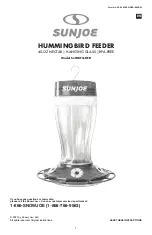
USF-1600 User Manual
- page 13 -
The platform allows reaching the loading box in a safe manner and performing all activities related to the seed
loading and machine maintenance.
The seed box is made of sheet metal in the shape of an inverted pyramid, fixed with brackets to the frame. A
tarpaulin is bolted to its upper part. There is a sowing unit and outlets for emptying the box in the lower part of
the box.
The motorized sowing unit is used to meter the right amount of seed. The sowing rate changes mechanically by
changing the position of the sowing cylinder (slots in the sowing unit.)
The electronically controlled motor, based on radar speed, rotates at the appropriate speed near the sowing
unit and meters the seed dose. In the mechanical version, the sowing units are driven directly from the star
wheel.
The manifold (distributor) serves to evenly divide the metered dose of seeds into individual sowing coulters.
The seeds from the manifold are blown into the pipes and then through the coulters to the soil.
The turbine is used to create pressure in the seed transport system necessary for transporting the seeds to the
manifold and coulters.
4. USING THE MACHINE
4.1. Loading and Unloading
CAUTION!
The seed box of the seeder must not be filled, if the unit is not coupled to the tractor.
Loading of the unit should take place by means of a crane, loader or conveyor. The seeds must be evenly
distributed over the entire surface of the load box at the same time.
4.2. Connecting and Setting the Blower.
CAUTION: The return line MUST be connected to the tractor tank = FREE RETURN, before starting the
turbine! Releasing a free return during operation may damage the turbine motor.
Connecting the blower
The oil delivery from the tractor must be at least 40L/min. below this value; the amount of oil may be
insufficient to simultaneously operate the blower and other hydraulic functions.
Turbine speed
It is difficult to indicate the correct speed of the turbine; it has to be determined by conducting field tests.
The turbine speed may not be too high, so as not to blow seeds out of the soil. It may also not be too
low, so that the seeds do not remain in the ducts, especially in the case of coarse seeds.

































